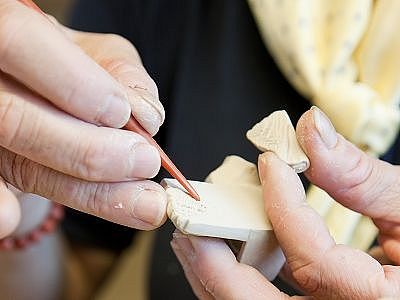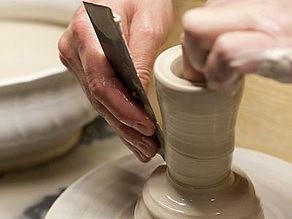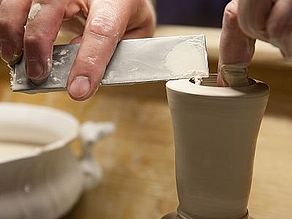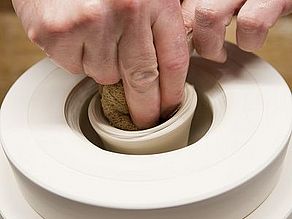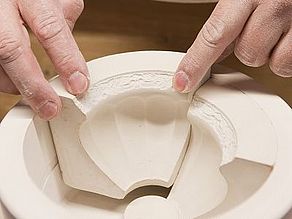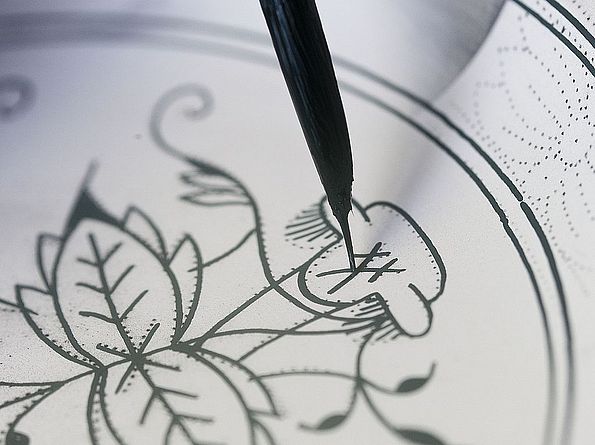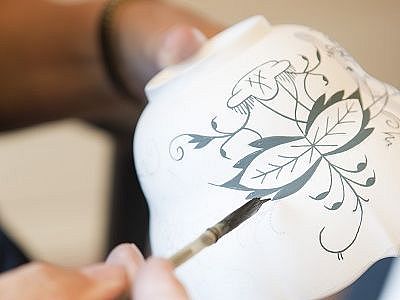Meissen Glossary
A
Appliqués are tiny moulded parts added to figurines or vessels. They are created in plaster press moulds by the repairers and luted on with slip when the figurine is assembled. Typical examples of appliqués are leaves, tendrils, flowerheads or decorative devices such as ribbons and bows.
Arcanists were those members of the Manufactory staff privy to the secrets of making porcelain. The term arcanum (Latin for “secret”) was originally used in the realm of alchemy, where it denoted the formula for creating gold so sought-after by alchemists. Once success was forthcoming in producing precious porcelain, however, the term arcanum was extended to signify the secrets of making porcelain. Along with the formula for porcelain paste, these also include knowledge about the glaze, the paints and colours used and firing behaviour.
B
Biscuit firing is the name given to the first firing porcelain undergoes. It is performed at around 900°C/1650°F once the ware has completely dried. Biscuit firing causes items to set and acquire a rough, highly absorbent surface. They are still very brittle and great care is required when moving them around.
Biscuit porcelain is the term given to porcelain fired without a glaze. It is no less impermeable than glazed porcelain, but has a coarser surface texture. The technique was much used for a time to create figurines with a look of marble or alabaster about them. It is still adopted these days in the fashioning of tableware and vessels.
A porcelain’s body thickness is that measured at a predefined point.
C
Casting is one of three methods of lending shape to porcelain paste in the process of creating wares in the material. It is, for instance, adopted for the production of thin-walled vessels (vases, Christmas baubles …) and involves the use of liquid porcelain paste (slip). The liquid porcelain paste is poured to the top of a sectional plaster mould. The plaster begins to absorb the water contained in the slip and porcelain paste settles against the interior walls of the plaster mould. After a while any slip left in the centre of the mould is poured back out. The thicker porcelain paste that has settled at the sides then has to be left in the mould until it has attained a leather-hard consistency and contracted a little, whereupon the plaster mould can be opened and the cast vessel removed.
Coloured or decorative grounds are areas of uniform colour most usually found on tableware or vases. Typical examples are the cobalt grounds on the flanges of plates or bodies of vases. Coloured grounds can be applied either by dabbing or spraying them on.
Crackle is the term applied to glaze decoration incorporating vividly coloured hairline cracks that have been artificially induced and envelop the entire vessel like fine mesh. The crackle technique was practised from very early on in Chinese porcelain production.
Chromatic mutation is a term used in the porcelain trade to denote a significant change of colour during firing. Chromatic mutation can occur in both underglaze and overglaze paints. The cobalt blue in Meissen’s Onion Pattern is a dull grey when applied. It only acquires its gleaming blue sheen during the glost firing process. Meissen purple is a dull brown when applied and only turns a brilliant purple in the course of being enamel fired.
D
Dabbing is a method of creating a coloured ground whereby paint is evenly daubed onto the porcelain using a flat-headed brush (with harder bristles).
Decoration denotes the art of painting on porcelain. To decorate porcelain is to embellish it with painted detail.
E
Enamel firing is the name given to the third firing porcelain undergoes. It is performed at around 900°C/1650°F on ware to which overglaze decoration has been applied. It causes the painted detail to adhere inseparably to the glaze and become durable as a result. Some colours alter in the course of enamel firing. Meissen’s famous gleaming purple is actually a dull brown prior to being fired in this way. Particularly intricate patterns require several rounds of enamel firing.
F
Figure painting, or staffage, denotes the likes of figures or animals rendered in a landscape picture and should not be confused with sculptural decoration.
Finishing-off is a routine adopted in porcelain painting, specifically in flower painting. It is the second stage in the painting process and is performed once the design has been “laid on” (flattish first draft). The motif can be finished off as soon as the design laid on has dried. Fine points of detail are added colour by colour. The motif’s three-dimensionality is sharpened up with the aid of shadow, variations in lightness and darkness within individual colours or else by areas of scumbling (application of a thin opaque coat of paint in order to produce a softer or duller effect).
G
Glost firing is the name given to the second firing porcelain undergoes. It is performed at around 1400°C/2550°F once the ware has been glazed. The ceramic body densifies, the ware shrinks by about a sixth, and the glaze becomes transparent, adhering tightly to the porcelain.
I
“In the wet” is a term popularly used by porcelain painters. It denotes a state that can, for instance, arise in sculptural decoration, i.e. the overglaze painting of figurines. Smooth areas of uniform chromatic intensity have to be applied without a break. It can take up to several hours to paint large areas constituting the likes of smooth coats. If the paint dries before the work has been completed, the “join” shows up and the quality of uniformity is lost. If someone in the Sculptural Decoration shop says “I’m in the wet”, it means their work must not be interrupted.
Intermediate firing is a form of enamel firing that is followed by the application of a further layer of decoration after which the ware is fired again. Intermediate firings are, for instance, conducted as a means of lending the painted detail in wall pictures or naturalist depictions of fruit added depth.
L
Lithophanes are images facilitated by the translucency of porcelain. They generally take the form of wafer-thin, unpainted, unglazed porcelain plaques in which a motif has been inscribed in relief. Their pictorial content becomes visible when they are held up to a source of light. Dark areas need to be applied thickly, lighter areas less so.
Laying-on is a routine adopted in porcelain painting, specifically in flower painting. It is the first stage in the actual painting process and is performed once the area to be painted on has been defined (pencil sketch). Laying-on yields a flattish first draft of the envisaged motif in all its colours that is clearly identifiable as such though still lacking in three-dimensional detail. This is added in the succeeding finishing-off stage.
The lustre colours painted on porcelain have a shimmeringly metallic, iridescent gleam that lends them the appearance of mother-of-pearl. Their lustrousness is brought about by a minute layer of metal (less than a ten-thousandth of a millimetre) that materialises during enamel firing. Lustre decoration on Persian ware is amongst the earliest known.
M
The initial version of a figurine or item of tableware to be produced in porcelain is referred to as the model. This will have been created by an artist or designer and forms the basis for serial production. The model is the point of departure for the making of moulds from which items can be cast over and over again in porcelain paste.
Moulding is one of three methods of lending shape to porcelain paste in the process of creating wares in the material. It is adopted in the production of figurines using porcelain paste that is soft and still moist. A moulder presses the porcelain paste into a sectional plaster mould. In the case of particularly large moulds, they first press or beat the porcelain paste into each half and subsequently lock the two together. The porcelain paste then needs to remain in the plaster mould long enough to enable the plaster to absorb some of the water from it. The parts shrink a little in the process, making it then easy to remove them from the mould. Once moulded, the various parts of a given figurine are then ready for the next stage in its production.
O
Openwork is the term used to describe a method of embellishing porcelain in which the decoration is actually cut out. Once the ware has been cast, a thin, very sharp knife is used to excise the relevant sections from the porcelain paste while it is still moist, leaving a porcelain design with gaps in between. Characteristic examples of openwork are plate flanges, dishes or etageres decorated with pierced basket-weave patterns or, indeed, pierced floral motifs.
Overglaze decoration is a method of painting on porcelain. It is applied over the glaze after the second firing (glost firing). Overglaze patterns are produced using either a paintbrush or steel pen. The piece then has to be subjected to a third “enamel” firing in order to fuse the paint with the glaze and render it durable. The colouring matter in the paints used takes the form of metal oxides. Some paints experience considerable chromatic mutation during enamel firing. Meissen’s famous gleaming purple, for instance, is actually a dull brown prior to being fired.
P
Pâte-sur-pâte is a form of decoration in which slip is painted onto a colour-stained ground. The term for the technique is French and literally means “paste-on-paste”. The underlying ground is made up of colour-stained porcelain paste. Several layers of slip (liquid porcelain paste) are applied to this to create the desired motif. Thin layers make for a more pellucid ground and hence appear darker, whilst thick layers are correspondingly lighter in appearance.
Pricked patterns are a resource used in porcelain painting. They are a kind of template employed as a means of defining the area to be painted on in fixed decorative schemes. The decoration’s outlines will have been pricked into them. The pricked pattern is placed on the piece to be painted and a bag of powdered charcoal or “pounce” rubbed over it, causing the charcoal to pass through the perforations. Removing the pricked pattern reveals the outlines of the decoration marked out on the piece to be painted, thus defining the area to be painted on.
R
Repairing is a specialist term used to describe part of the process of making a figurine. It signifies the assembly of a porcelain figurine from its individual parts. These consist of moist, still shapeable porcelain paste that must not be allowed to dry out before the work has been completed. First the various parts are sharpened up, excess porcelain paste is removed, and details such as hair or finger nails are added. Then the figurine is joined together bit by bit using slip (liquid porcelain paste) as a binding agent. Once the figurine is complete, it is gone over again in its entirety and, where necessary, appliqués are added before it has dried.
S
Sculptural decoration is a form of overglaze painting and chiefly relates to the painting of figurines. It is an art that has been subject to constant change over the centuries. Variations on a theme were common in the 18th century: within certain predefined limits it was the sculptural decorators who determined what figurines wore. In the late 19th century, pieces began to be given a touch of history. They were painted to look older. The 20th century saw the emergence of figurines decorated to rigid rules whilst the present century is witnessing the adornment of figurines with classic tableware patterns. The German word is “Staffage”, which usually has a different meaning in English (see Figure painting).
Shrinkage is a phenomenon to which porcelain is subject when being made. Meissen porcelain shrinks to the greatest degree in the course of being glost-fired, by about 16 % to be precise. The Böttger Stoneware likewise produced at the Meissen Porcelain Manufactory also shrinks in the course of being made, though only by roughly 12 %.
Slip is the term used to describe liquid porcelain paste. Slip is used to join the parts of a figurine being produced together. In tableware production it is used to cast vessels such as vases and pots.
T
Throwing is one of three methods of lending shape to porcelain paste in the process of creating wares in the material. It is performed on a potter’s wheel using soft porcelain paste. It is in principle possible to “hand-throw” porcelain just as one can any other form of clay. Porcelain is less ductile, however, and tends to develop cracks or go out of shape when hand-thrown. It is generally “jiggered” in plaster moulds for this reason. This first involves throwing a basic shape known as a “slug”. The plaster mould is then fastened to the potter’s wheel and the slug of soft porcelain paste placed inside the mould. The mould is now rotated so as to cause the porcelain paste to rise up against the interior faces of the plaster mould. In the process, any relief decoration applied to the inside of the mould is transferred to the outside of the vessel. A tool known as a die is then used to remove any surplus porcelain paste from the inside of the vessel and shape its interior. The jiggered vessel now has to remain inside its plaster mould until the plaster has absorbed some of the water from the porcelain paste. The vessel shrinks minimally as a result and can then be removed with ease.
U
Underglaze decoration is a method of painting on porcelain. It is applied to the porcelain after an initial biscuit firing. The surface of the as yet unglazed porcelain is still absorbent. Underglaze patterns are brushed on. Great accuracy is called for here, since the paint is immediately soaked up by the ceramic body and any mistakes made cannot be rectified. The paints used need to be exceedingly heat resistant given that, once a piece has been painted in this way, it is glazed and fired a second time at around 1400°C/2550°F. Underglaze patterns emerge from this second firing (glost firing) covered by a glaze that affords them complete protection. The most famous form of underglaze decoration at Meissen is the Onion Pattern.
![[Translate to English:] [Translate to English:] Meissen A - Z, Die Welt der Porzellankunst entdecken](/fileadmin/user_upload/museum/expertenwissen/meissen_a_-_z__1080_x_980_px_.png)

